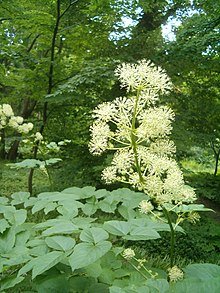 Image 1 of 1
Image 1 of 1


Aralia (Araliaceae)
Aralia is an interesting genus of trees, shrubs, and herbaceous perennials. There are over 70 species with worldwide distribution. The family araliaceae encompasses such plants as ginseng, sarsaparilla and eluthrococus. Many of the species have been used medicinally. A. racemosa is a wonderful, native and ornamental plant with a range encompassing most of the Eastern US. Commonly known as American spikenard (an erroneous name at best), the greenish white flowers come out in June and July on lovely arching, tapered stems from 4’-6’ followed by red, edible and pleasant tasting berries that persist into the fall. Though often found growing in the light shade and woodland edges, it seems to do fine in full sun, growing into a fuller specimen. Adaptable, but responds to rich soil. We have been propagating this slow growing plant from seeds gathered locally and now have some nice size stock. Aralia is slow to establish, but once it does can grow quite large and is difficult to move. Choose a location carefully.
AVAILABLE IN 2026
A. cashmerica - Himilayan native, white flowers followed by black berries. A stockier and fuller plant than A. racemosa.
A. racemosa - Northeastern US native, white flowers followed by red berries. Pollinator, birds eat the berries in fall.
Sold in deep 6” pots. Large, well started plants!
Aralia is an interesting genus of trees, shrubs, and herbaceous perennials. There are over 70 species with worldwide distribution. The family araliaceae encompasses such plants as ginseng, sarsaparilla and eluthrococus. Many of the species have been used medicinally. A. racemosa is a wonderful, native and ornamental plant with a range encompassing most of the Eastern US. Commonly known as American spikenard (an erroneous name at best), the greenish white flowers come out in June and July on lovely arching, tapered stems from 4’-6’ followed by red, edible and pleasant tasting berries that persist into the fall. Though often found growing in the light shade and woodland edges, it seems to do fine in full sun, growing into a fuller specimen. Adaptable, but responds to rich soil. We have been propagating this slow growing plant from seeds gathered locally and now have some nice size stock. Aralia is slow to establish, but once it does can grow quite large and is difficult to move. Choose a location carefully.
AVAILABLE IN 2026
A. cashmerica - Himilayan native, white flowers followed by black berries. A stockier and fuller plant than A. racemosa.
A. racemosa - Northeastern US native, white flowers followed by red berries. Pollinator, birds eat the berries in fall.
Sold in deep 6” pots. Large, well started plants!

